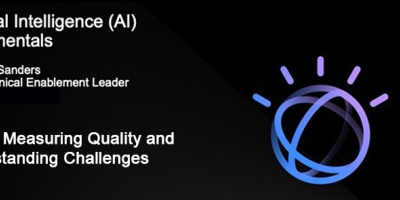Incorporating artificial intelligence (AI) into your enterprise's business processes isn't like installing a new accounting program. It requires strong leadership, vision, and a willingness to consider questions some in the organization may think are already settled issues.
Odds are, if you're interested in AI, one of the reasons is that you see it as something your organization could use to boost its bottom line. You'd be right about that, but getting there is anything but a typical IT project. To be maximally effective, AI adoption calls for contemplating a transformational strategy that goes beyond mere technology to include a business's strategic goals, its ways of doing business, its people, and even its corporate culture. The benefits can be huge, but the process of getting there will likely require a re-evaluation of some fundamental aspects of your organization and its business.
Where's the Fire, Buddy?
If you're looking into AI because your CEO or some other bigwig read an article somewhere about how someone saw a quarterly jump in profits from it and your leader has decided that would be so cool to do that he or she has delegated someone to "look into it," your organization has likely already taken its first giant step down the road of AI adoption failure. AI transformation isn't an experiment or a fix or a new toy. It calls for reimagining how your enterprise relates to itself and perhaps even the whole business world. There are many steps to get there, and each has to be considered thoroughly and taken quite deliberately. Rushing anything risks creating a pitfall that could ensnare and doom the whole effort.
AI transformation needs to be led from the top and requires determination on the part of the leadership. That's because transformation upsets a lot of apple carts. It often requires reorganization of priorities, as well as how tasks are carried out, and such actions require overcoming institutional inertia and entrenched views. Only top leadership, or someone with top leadership's backing, has the clout to see that through. Top leadership must be committed and actively involved in formulating these strategies, and the leadership must also understand how sweeping change might need to be to move to a business model that incorporates AI.
Setting aside the sphere of AI that includes robotic automation of manufacturing processes as beyond the scope of this article, let's instead narrow this discussion to enterprises that provide services, or some kind of products in which the organization may not be involved in the manufacturing so much as distribution or marketing. At the center of operations for this kind of enterprises is data. Data about consumer habits, for example, or about competing products. Or perhaps the "product" is data itself. Even if it isn't, data is a good place to start thinking strategically about AI adoption.
Strategies at the Center of Transformation
Many transformation experts recommend that formulating an AI strategy requires parallel development of a data strategy. A data strategy deals with elements such as what data an enterprise will need to carry out a particular set of tasks, what processes will support verifying and accessing the data, and what technology will be used to store and safeguard it.
A specific data strategy is necessary because adopting AI in most contexts is largely a process of figuring out how better to use data not only to operate existing business processes, but to formulate and carry out probable future business initiatives. What data will the enterprise need to make best use of adopting AI, and how will that data be provided on an ongoing basis? Because using datasets to "train" an AI system is central to the process of adopting AI, another big aspect of data strategy is deciding what data to use to train the system so it can analyze future input in a way that's helpful and meaningful to organizational business goals.
By the way, what are those organizational goals? When's the last time they were reviewed? Will adopting AI create some opportunities that might change what an organization's current goals might be? If the probable answer to that last question is "yes," whose assignment will that part be? This sort of reassessment also needs to be part of an AI strategy.
An AI strategy is concerned with such strategic decisions as the technology that will support AI use (as opposed to simply providing access to the data that will support the strategy), ethical safeguards, and the potential changes to an enterprise's business model that can increase AI's benefits.
In fact, developing an AI strategy can touch so many areas of a company's operations that, unless you're simply focusing on a feasibility study or a single pilot project, it's a good idea to form a project team tasked with formulating these strategies and investigating what it might take to follow up on them.
The Data Strategy
At the top level, building a data strategy needs to include multiple major areas. These consist of acquiring and processing data, making sure the data used is both valid and pertinent, deciding in what context the data will be analyzed, and finally the issues one has with the contents of any database—how to store it, how to provision users to access it, and how to manage and secure it. Another important component is the decision of whether to store data in-house or to rely on third-party data storage via the cloud or a VPN.
Another important consideration is how to find new data to analyze that's pertinent to the enterprise's line of business. For example, let's say one task a strategy identifies is the need to have better data about why customers buy certain products. How can that be obtained? There's probably lots of data about how many products are being sold but not so much on why they've been purchased. Will this require a new method of surveying customers, for example? How can the organization get the names and contact information of people to survey? What system will be used to collect, store, and analyze just that data, particularly if there's no current system for doing that? That's going to be just one piece of one task tied to one objective.
Protecting the data from unauthorized access and use requires particular attention because, in many cases, the AI will need to analyze, for example, consumer data on behavior and preferences to determine what products and services the enterprise needs to modify to keep market share. Such data is sensitive. While the U.S. lags a bit in this area, E.U. and U.K. laws, for instance, require extra protections for consumers' personal information. If you're trying to analyze market trends, you'll need data on consumer buying habits, for example, and that certainly could be classified as "personal information."
One way to begin building a data strategy is to have an outside consultant come in to analyze the enterprise's existing data structures, content, and arrangements. This can help give a clearer idea of what changes might be necessary to support AI.
The AI Strategy
An AI strategy needs to address different issues. What can the business get from AI in the first place? Will or should business priorities change as a result of AI adoption? What goals and key performance indicators (KPIs) does the business need to reach in order to define success? What new technology and infrastructure will be needed to support a transformation? What skills will employees need that they don't currently have? Will adding those skills require additional training, or will it necessitate hiring new talent? Will the enterprise need to partner with outside companies for strategic planning, data acquisition, training, or other services? How will the organization implement an AI system once a decision is made about what it needs to do? An AI strategy needs to address all these areas in general, and there will be additional aspects depending on the enterprise's lines of business.
Not to belabor this, because it's been covered in previous articles (parts 1 and 2), but how will the enterprise handle potential ethical problems in an AI system? How will it avoid bias in how its AI processes data? How can it avoid unintentional biases originating with the people who decide what data to use to train the system? Who even gets to decide what might be categorized a "bias" in a world where one person's "common sense" is someone else's "evidence of bias?" Like an iceberg, these issues are simply some of those that are evident at the top. All of them lead to many other questions hiding below the water line.
The AI strategy at least partly needs to take into account how capable and flexible the enterprise's current team and corporate culture will be at accepting and adapting to the whole process. Reviewing and reimagining how the company might do business in an AI environment calls for a comprehensive reassessment.
Major Use Cases
AI strategy needs to be based on specific business goals, and initial projects need to have measurable objectives. A useful adjunct to creating both a data and an AI strategy is to focus early on what are termed major use cases. These are basically outlines of concrete scenarios in which AI could fulfill a specific function for the organization. For example, does the enterprise need AI to formulate creation of new products and services? Or will the goal instead be automating processes, helping decide how to set prices, creating a better experience for customers, or some other goal?
These use cases will vary with the type of business in which the enterprise is engaged. Enumerating these use cases will also help structure how to determine what questions need to be answered to decide if a larger-scale AI transformation is a viable option.
To identify use cases will involve interviewing managers, employees, and customers to identify processes that could use modification and to have them imagine ways in which AI might otherwise provide business benefits. Are there even new lines of business that having better data analysis might support?
Once some use cases have been identified, a project team can explore how effective a particular case might be in improving business results, as well as how difficult it might be to bring it about and what kind of priority the use case should be given compared to other proposed ideas.
Also included in the AI strategy should be a couple of minor project ideas, such as improving a specific process. Such "lighthouse" projects can help the organization walk through the steps of building an initial strategic plan on a smaller scale. Success in a small project can then build confidence in larger plans later without the prospect seeming as overwhelming as a transformation may appear at first. This is important because if the goals of the organization do lead to a decision to use AI to transform the business, everyone involved will need to realize that AI adoption ultimately leads to a corporate culture of continual change and improvement. That's a mindset not everyone will find comfortable.
AI Transformation: Daunting but Not Impossible
Coming up with a strategy to incorporate AI into your business is a big task, but over the next 10 years, doing that may prove to be a major differentiator between companies that are still thriving in the 2030s and those that are a memory. The technology is out there, and enterprises are going to learn to use it. The sooner you consider using AI, the further ahead you will be compared to competitors who simply dismiss the idea out of hand as being too expensive or complicated. AI transformation can be both, but in this digital age, automating internal processes and data analysis is a conversion nearly all successful businesses are going to have to consider.
Although it's beyond the scope of this article, there is a growing number of consulting companies offering advice on how to approach the whole concept of AI transformation, how to formulate strategies, how to find additional resources, and how to implement AI-related changes. These consultants can be brought in at any stage of the process, but initial efforts can start out less formally. However, they do need to start sometime. Don't be left behind.























 More than ever, there is a demand for IT to deliver innovation. Your IBM i has been an essential part of your business operations for years. However, your organization may struggle to maintain the current system and implement new projects. The thousands of customers we've worked with and surveyed state that expectations regarding the digital footprint and vision of the company are not aligned with the current IT environment.
More than ever, there is a demand for IT to deliver innovation. Your IBM i has been an essential part of your business operations for years. However, your organization may struggle to maintain the current system and implement new projects. The thousands of customers we've worked with and surveyed state that expectations regarding the digital footprint and vision of the company are not aligned with the current IT environment. TRY the one package that solves all your document design and printing challenges on all your platforms. Produce bar code labels, electronic forms, ad hoc reports, and RFID tags – without programming! MarkMagic is the only document design and print solution that combines report writing, WYSIWYG label and forms design, and conditional printing in one integrated product. Make sure your data survives when catastrophe hits. Request your trial now! Request Now.
TRY the one package that solves all your document design and printing challenges on all your platforms. Produce bar code labels, electronic forms, ad hoc reports, and RFID tags – without programming! MarkMagic is the only document design and print solution that combines report writing, WYSIWYG label and forms design, and conditional printing in one integrated product. Make sure your data survives when catastrophe hits. Request your trial now! Request Now. Forms of ransomware has been around for over 30 years, and with more and more organizations suffering attacks each year, it continues to endure. What has made ransomware such a durable threat and what is the best way to combat it? In order to prevent ransomware, organizations must first understand how it works.
Forms of ransomware has been around for over 30 years, and with more and more organizations suffering attacks each year, it continues to endure. What has made ransomware such a durable threat and what is the best way to combat it? In order to prevent ransomware, organizations must first understand how it works. Disaster protection is vital to every business. Yet, it often consists of patched together procedures that are prone to error. From automatic backups to data encryption to media management, Robot automates the routine (yet often complex) tasks of iSeries backup and recovery, saving you time and money and making the process safer and more reliable. Automate your backups with the Robot Backup and Recovery Solution. Key features include:
Disaster protection is vital to every business. Yet, it often consists of patched together procedures that are prone to error. From automatic backups to data encryption to media management, Robot automates the routine (yet often complex) tasks of iSeries backup and recovery, saving you time and money and making the process safer and more reliable. Automate your backups with the Robot Backup and Recovery Solution. Key features include: Business users want new applications now. Market and regulatory pressures require faster application updates and delivery into production. Your IBM i developers may be approaching retirement, and you see no sure way to fill their positions with experienced developers. In addition, you may be caught between maintaining your existing applications and the uncertainty of moving to something new.
Business users want new applications now. Market and regulatory pressures require faster application updates and delivery into production. Your IBM i developers may be approaching retirement, and you see no sure way to fill their positions with experienced developers. In addition, you may be caught between maintaining your existing applications and the uncertainty of moving to something new. IT managers hoping to find new IBM i talent are discovering that the pool of experienced RPG programmers and operators or administrators with intimate knowledge of the operating system and the applications that run on it is small. This begs the question: How will you manage the platform that supports such a big part of your business? This guide offers strategies and software suggestions to help you plan IT staffing and resources and smooth the transition after your AS/400 talent retires. Read on to learn:
IT managers hoping to find new IBM i talent are discovering that the pool of experienced RPG programmers and operators or administrators with intimate knowledge of the operating system and the applications that run on it is small. This begs the question: How will you manage the platform that supports such a big part of your business? This guide offers strategies and software suggestions to help you plan IT staffing and resources and smooth the transition after your AS/400 talent retires. Read on to learn:
LATEST COMMENTS
MC Press Online